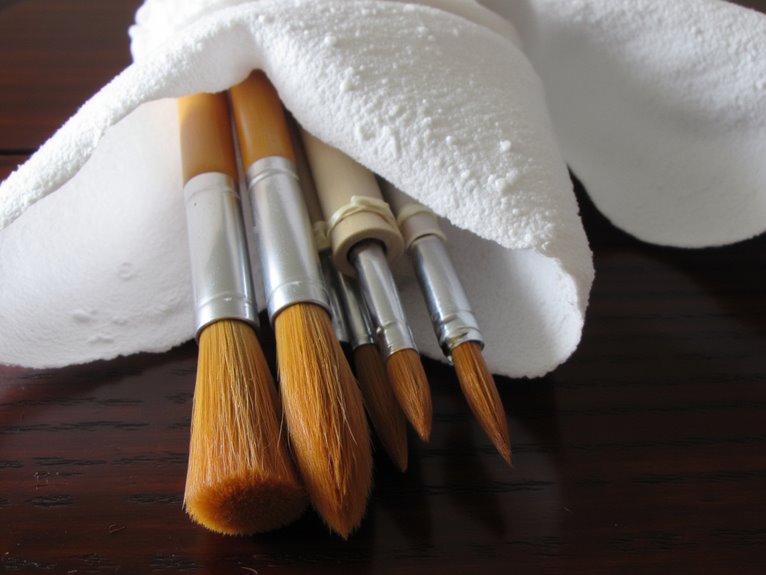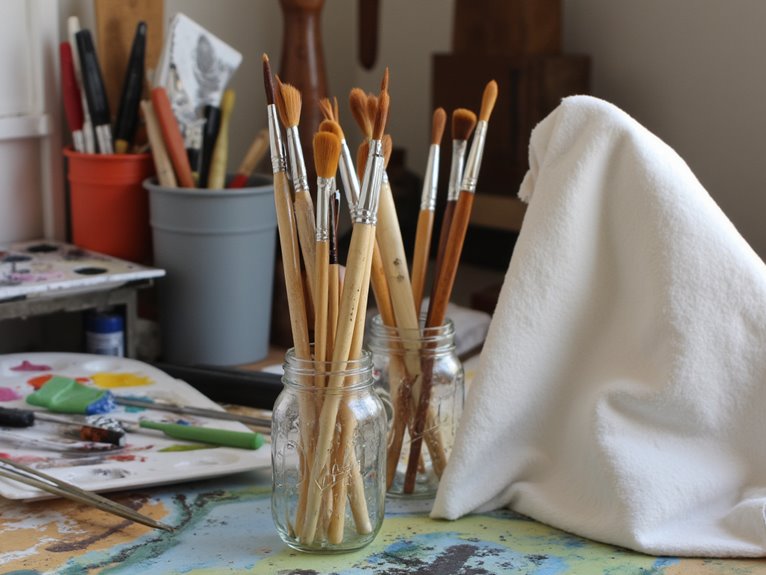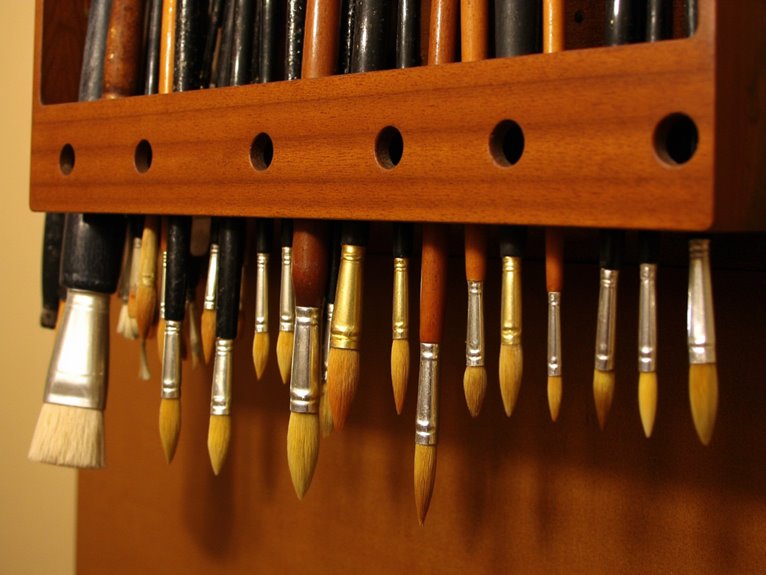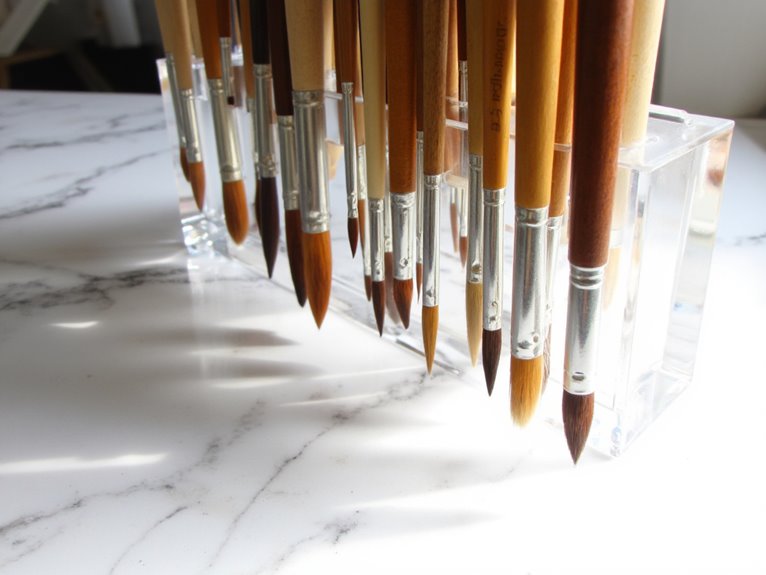We are supported by our audience. When you purchase through links on our site, we may earn an affiliate commission, at no extra cost for you. Learn more. Last update on 1st July 2025 / Images from Amazon Product Advertising API.
For ideal brush storage, you’ll need to clean thoroughly with warm water and mild soap, then reshape bristles while damp. Store brushes upright in a cool, dry location with controlled humidity below 50% to prevent mold growth. Use protective cases or sealed containers with silica gel packets to absorb excess moisture. Avoid extreme temperatures and direct sunlight that can warp bristles and damage ferrules. Proper environmental control and positioning techniques will greatly extend your brush investment’s performance lifespan.
Notable Insights
- Store brushes upright after thorough cleaning and complete drying to maintain shape and prevent bristle deformation.
- Use airtight containers with silica gel packets in cool, dry locations away from extreme temperatures and humidity.
- Clean brushes immediately after use with appropriate solvents—warm soapy water for water-based paints, mineral spirits for oil-based.
- Employ protective cases or multi-compartment organizers to prevent physical damage and keep brushes dust-free during storage.
- Avoid storing brushes in basements or bathrooms where excessive moisture can cause mold growth and bristle damage.
Removing Excess Paint Before Storage
Before storing any paintbrush, you’ll need to remove excess paint from the bristles to prevent permanent damage and guarantee peak performance for future use. Press the brush against the paint can’s inside lip to eliminate large paint quantities. This initial paint removal step reduces subsequent cleaning time by up to 50%.
Brush remaining paint onto scrap cardboard or paper to extract additional residue from deep within the bristles. Use an old rag or paper towel to wipe excess paint, maintaining the brush’s original shape.
This systematic approach to brush maintenance prevents paint from hardening on bristles, which complicates future cleaning processes. Remove as much paint as possible before proceeding to washing steps, as dried paint creates permanent bristle damage and reduces brush lifespan considerably. For stubborn paint buildup, use a brush comb to gently work through the bristles and ensure complete removal of all paint residue. High-quality brushes represent a significant investment that requires proper maintenance to preserve their functionality and extend their useful life. Water-based primers typically allow for easier cleanup compared to oil-based alternatives, reducing the time needed for brush maintenance.
Wrapping Techniques to Maintain Moisture

You’ll need proper wrapping techniques to keep your brushes moist and ready for the next coat without constant cleaning.
Plastic wrap and aluminum foil create moisture barriers that prevent paint from drying on bristles for 2 to 4 hours when applied correctly.
The key lies in achieving completely airtight seals that trap existing moisture while blocking air exposure that causes paint to harden.
For added protection during these short breaks, place your wrapped brush in a sealed plastic bag to maintain freshness more effectively.
When work is interrupted mid-prime, refrigerate wrapped brushes to extend their usable time and prevent paint deterioration.
Plastic Wrap Methods
Plastic wrap serves as one of the most effective temporary solutions for maintaining brush moisture during painting breaks, creating an airtight barrier that prevents paint from drying on bristles for up to 48 hours. The plastic wrap benefits include immediate moisture retention without requiring solvent cleaning.
For efficient wrapping, you’ll need to follow specific steps:
- Remove excess paint from bristles before wrapping to maintain brush shape
- Wrap the entire brush head snugly, ensuring complete enclosure of all bristles
- Seal plastic wrap around the brush neck with masking tape for enhanced airtightness
Cooler storage temperatures greatly reduce drying rates. Refrigeration can extend effectiveness up to two days when combined with proper wrapping techniques.
However, this method works best for water-based paints and isn’t suitable for long-term storage exceeding 48 hours. When wrapping is complete, avoid upright storage which can cause bristles to bend and lose their proper shape. After removing the plastic wrap, you can reshape bristles with boiling water if they have become misformed during storage.
Airtight Sealing Tips
While plastic wrap provides excellent temporary protection, achieving truly airtight seals requires specific wrapping techniques that eliminate all air exposure around paint-loaded bristles.
Aluminum foil creates superior airtight wrapping compared to other materials due to its firmness and moldability. Wrap tightly enough to prevent air penetration but gently enough to preserve bristle shape. Multiple layers enhance protection without causing compression damage.
| Material | Seal Quality | Best Use Case |
|---|---|---|
| Aluminum Foil | Excellent | Long-term storage |
| Wax Paper | Good | Short-term protection |
| Plastic Wrap | Very Good | General wrapping |
| Vacuum Bags | Superior | Professional storage |
| Brush Guards | Excellent | Shape retention |
Place wrapped brushes inside sealed plastic bags for enhanced moisture control. Add silica gel packs to absorb residual moisture. Store in cool, dry areas away from direct sunlight to prevent accelerated paint drying and bristle deterioration. Position the wrapped brush flat or slightly tilted with bristles facing downwards to prevent paint from seeping into the ferrule and maintain optimal brush performance.
Optimal Storage Positioning for Brush Health
Because proper positioning directly affects brush longevity and performance, the orientation you choose for storage becomes a critical factor in maintaining your brushes’ structural integrity. Vertical storage with bristles facing upward prevents deformation and maintains natural alignment. This positioning enhances air circulation, promoting faster drying essential for brush hygiene and moisture control.
Key positioning principles include:
- Store bristles upward to prevent flattening and preserve shape integrity
- Avoid horizontal placement which causes bending, splaying, and premature wear
- Use dedicated holders designed for vertical storage to maintain proper spacing
Never rest brushes on their bristles, as this leads to permanent deformation. Proper vertical positioning reduces bacterial growth by eliminating moisture accumulation.
Overcrowding compromises air circulation and causes brushes to press against each other, resulting in bristle damage and reduced effectiveness. Choose holders with multiple diameter holes to accommodate varied brush sizes and prevent crowding that can damage ferrules.
Creating the Right Storage Environment
The storage environment you create determines whether your brushes maintain their performance or deteriorate rapidly over time. Proper humidity control prevents mildew growth and bristle damage, while temperature consistency maintains brush durability by preventing glue degradation from expansion and contraction cycles.
Store your brushes in cool, dry locations away from direct sunlight. Basements and bathrooms create excessive moisture that damages bristles. Use dehumidifiers when ambient humidity exceeds safe levels.
| Environmental Factor | Ideal Condition | Consequence of Poor Control |
|---|---|---|
| Temperature | Consistent room temp | Glue weakens, ferrules loosen |
| Humidity | Low moisture levels | Mildew growth, bristle rot |
| Light Exposure | Avoid direct sunlight | Color fading, bristle brittleness |
Silica gel packets in storage containers absorb excess moisture effectively. Airtight containers provide additional protection from environmental fluctuations that compromise brush integrity. Follow the maintenance recommendation from brush manufacturers to store brushes in upright storage positions after cleaning, which maintains brush shape and performance over time.
Short-Term Storage During Active Projects

When you’re working on multi-day projects, you’ll need reliable methods to keep your brushes in perfect condition between coats and during quick work breaks.
The key is preventing paint from drying on the bristles while maintaining their shape and responsiveness for immediate use when you return to work.
These storage techniques will save you time and preserve your brush investment by eliminating the need for thorough cleaning after every short pause in your painting process.
Between Coat Storage Methods
While painting multi-coat projects, you’ll need reliable methods to keep your brushes workable between applications without performing a full cleaning each time.
Different brush types require specific storage containers to maintain bristle integrity and paint consistency.
The most effective between-coat storage methods include:
- Plastic wrap sealing – Wrap the entire brush head tightly with plastic wrap, securing around the neck with masking tape for up to two days.
- Water suspension – Submerge bristles in a gallon can filled with water, maintaining usability for three days maximum.
- Partial paint immersion – Leave the bottom third of bristles in wet paint for extremely short breaks during active work.
These techniques eliminate repeated cleaning cycles while preserving brush performance and paint quality throughout your project timeline.
Quick Break Preservation Techniques
Beyond overnight storage solutions, active painting sessions require even faster preservation methods when you’re stepping away for minutes or hours rather than days.
Submerge the bottom one-third of bristles in paint to prevent brush drying during short pauses. This technique maintains moisture while preserving your brush’s ability to deliver smooth application when you resume work.
For breaks lasting up to two hours, wrap brush heads tightly in plastic wrap or resealable bags. Seal the brush neck with masking tape to create an airtight barrier.
Store brushes horizontally or bristle-down in cool locations away from heat sources. Avoid overloading bristles with paint, as excess material can cause clumping and shape deformation during storage periods.
Managing Brushes During Brief Work Breaks
During painting projects that require brief interruptions, you’ll need specific storage techniques to keep your brushes workable without compromising bristle quality.
Proper brush frequency management during short breaks prevents paint from drying while maintaining bristle integrity. Leave the bottom one-third of bristles dipped in paint for breaks under 30 minutes. For longer pauses up to 24 hours, wrap brush heads tightly with plastic wrap or place them in airtight sandwich bags.
Keep brushes workable during painting breaks by leaving bristles partially in paint for short pauses or wrapping tightly for longer interruptions.
Your handling practices should include:
- Store wrapped brushes in refrigerators or cool areas to extend usability
- Position brushes flat on drop cloths rather than standing on bristles
- Blot excess paint gently before wrapping to prevent overloading
Avoid water soaking, which damages bristle shape.
These techniques maintain brush performance without requiring full cleaning between work sessions. Proper storage recommendations help prevent wear and prolong lifespan of your brushes, especially important given that high-quality brush sets are considered a great investment for painters.
Sealing Methods for Extended Pauses
Extended pauses of 24 hours or more require advanced sealing techniques that go beyond basic wrapping methods. For ideal brush longevity, you’ll need airtight barriers that maintain consistent moisture retention around bristles.
Remove excess paint first, then wrap bristles tightly with plastic wrap or aluminum foil. Avoid air pockets that accelerate drying. Store brushes flat or tilted slightly downward to prevent paint seepage into ferrules.
| Material | Sealing Duration | Best For |
|---|---|---|
| Plastic wrap | 2-3 days | Water-based paints |
| Aluminum foil | 4-5 days | Oil paints |
| Airtight containers | 1 week | Multiple brushes |
Oil paints maintain workability longer than water-based formulations under sealed conditions. Check periodically for moisture accumulation or mold growth during extended storage periods.
Thorough Cleaning After Project Completion

Clean your brushes immediately after finishing any painting project to prevent permanent damage and extend their working life.
Use warm water and mild soap for water-based paints, or turpentine and mineral spirits for oil-based formulations.
Don’t let brushes soak for extended periods, as this damages both bristles and ferrules.
Begin mechanical cleaning by gently working solvent into bristles using your finger or a brush comb to dislodge trapped paint residue.
Rinse thoroughly under warm running water until all paint and solvent disappear completely.
Avoid aggressive scrubbing that can damage bristle tips or cause splaying.
For synthetic brushes with dried paint, specialized hard-reset cleaners can effectively restore them.
Multiple cleaning cycles may be necessary for brushes used with thick or multiple paint layers.
Selecting Appropriate Cleaning Solvents
You’ll face a fundamental choice between water-based and solvent-based cleaners when selecting the right cleaning solvent for your brushes.
Water works effectively for water-soluble paints like acrylics and watercolors, while mineral spirits with a flashpoint around 144°F provide safer oil paint removal compared to harsh alternatives like acetone or chlorinated solvents.
The key is matching your solvent’s strength to your paint type without exposing your brush fibers to unnecessarily aggressive chemicals that can break down natural bristles or damage synthetic filaments.
Water Vs Mineral Spirits
The choice between water and mineral spirits determines both your cleaning success and brush longevity. Water-based solutions excel with latex paints, while mineral spirits handle oil-based products effectively. Your cleaning routines must match the paint type to avoid bristle damage.
For water-based paints, these solutions deliver excellent results:
- Warm water with dish soap dissolves paint residues completely
- Murphy’s oil soap conditions bristles while cleaning thoroughly
- Fabric softener provides moderate paint removal but requires follow-up cleaning
Mineral spirits work best for oil-based paints but can harden water-based materials on bristles. They’re flammable and require ventilation, unlike water-based alternatives that remain non-toxic.
Proper brush maintenance demands matching your solvent to paint composition—water solutions preserve bristle flexibility while mineral spirits may strip natural oils with excessive use.
Avoiding Harsh Chemical Damage
While harsh solvents promise quick paint removal, they’ll destroy your brushes faster than you can replace them.
Chemical cleaners containing strong acids, alkalis, or highly volatile compounds degrade bristles and weaken ferrule attachments. Your brush health depends on selecting gentle alternatives like Murphy’s Oil Soap, walnut oil, or baby shampoo for regular maintenance. These non-toxic options effectively remove paint deposits without stripping natural oils from animal hair bristles.
Cleaning frequency increases when you use harsh chemicals because damaged brushes require more maintenance. Avoid prolonged soaking in any solvent—it causes bristle brittleness and loosens glue bonds.
Test new solvents on small brush areas first. Choose biodegradable, non-toxic cleaners that won’t cause handle swelling or bristle shedding for ideal brush longevity.
Reshaping and Drying Techniques

Once you’ve finished your painting session, proper reshaping and drying techniques become critical for maintaining your brushes’ performance and extending their lifespan. Effective brush maintenance starts with thorough cleaning to remove all paint residues before reshaping begins.
While your brush remains wet and soapy, gently reshape the bristles with your fingers or roll them on cloth. For severely splayed brushes, hold bristles underwater for 10-15 seconds to soften before manipulation.
Essential bristle care practices include:
- Proper drying position: Lay brushes flat on their side to prevent water from entering the ferrule
- Avoid vertical storage: Never dry brushes upright or bristles-down as this causes deformation
- Remove brush caps: Caps trap moisture and damage bristles during drying
Allow complete air drying in ventilated areas before storage.
Vertical Storage Methods for Longevity

After your brushes have dried completely, proper vertical storage becomes your primary defense against bristle deterioration and ferrule damage.
Position brushes upright with bristles facing up to maintain ideal brush alignment and prevent warping. This orientation allows residual moisture to drain away from the ferrule, reducing corrosion risks considerably.
Store brushes in cool, dry environments with humidity levels below 50%. Use silica gel packs within storage containers to absorb excess moisture. Individual dividers prevent bristle entanglement while maintaining proper spacing. Airtight containers provide superior bristle protection against dust and environmental contaminants.
Avoid storing wet brushes or leaving them in water extended periods. The adhesive holding bristles weakens, causing bristle loss.
Check stored brushes monthly for rust formation or bristle damage to guarantee continued performance.
On a final note
You’ve learned the essential techniques for preserving your brushes’ performance and extending their lifespan. Proper paint removal, moisture control, and vertical storage positioning form the foundation of effective brush care. Environmental factors like temperature stability and dust protection directly impact bristle integrity. Whether you’re storing brushes short-term during active projects or long-term between painting sessions, these methods will maintain ideal brush condition and guarantee consistent paint application for years.
